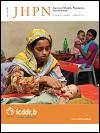Epidemiology of Rotavirus and Cholera in Children Aged Less Than Five Years in Rural Bangladesh
DOI:
https://doi.org/10.3329/jhpn.v29i1.7560Keywords:
Cholera, Diarrhoea, Hospitalizations, Rotavirus infections, Vibrio cholerae, BangladeshAbstract
Despite the known presence of rotavirus-associated diarrhoea in Bangladesh, its prevalence, including records of hospitalization in rural health facilities, is largely unknown. In a systematic surveillance undertaken in two government-run rural health facilities, 457 children, aged less than five years, having acute watery diarrhoea, were studied between August 2005 and July 2007 to determine the prevalence of rotavirus. Due to limited financial support, the surveillance of rotavirus was included as an addendum to an ongoing study for cholera in the same area. Rotavirus infection was detected in 114 (25%) and Vibrio cholerae in 63 (14%) children. Neither rotavirus nor V. cholerae was detected in 280 (61%) samples; these were termed ‘non-rotavirus and non-cholera’ diarrhoea. Both rotavirus and cholera were detected in all groups of patients (<5 years). The highest proportion (41%; 47/114) of rotavirus was in the age-group of 6-11 months. In children aged less than 18 months, the proportion (67%; 76/114) of rotavirus was significantly (p<0.001) higher than that of cholera (16%; 10/63). By contrast, the proportion (84%; 53/63) of cholera was significantly (p<0.001) higher than that of rotavirus (33%; 38/114) in the age-group of 18-59 months. During the study period, 528 children were hospitalized for various illnesses. Thirty-eight percent (202/528) of the hospitalizations were due to acute watery diarrhoea, and 62% were due to non-diarrhoeal illnesses. Rotavirus accounted for 34% of hospitalizations due to diarrhoea. Severe dehydration was detected in 16% (74/457) of the children. The proportion (51%; 32/63) of severe dehydration among V. cholerae-infected children was significantly higher (p<0.001) compared to the proportion (16%; 18/114) of rotavirus-infected children. The study revealed that 12-14% of the hospitalizations in rural Bangladesh in this age-group were due to rotavirus infection, which has not been previously documented.
Key words: Cholera; Diarrhoea; Hospitalizations; Rotavirus infections; Vibrio cholerae; Bangladesh
DOI: 10.3329/jhpn.v29i1.7560
J HEALTH POPUL NUTR 2011 Feb;29(1):1-8
Downloads
371
235

